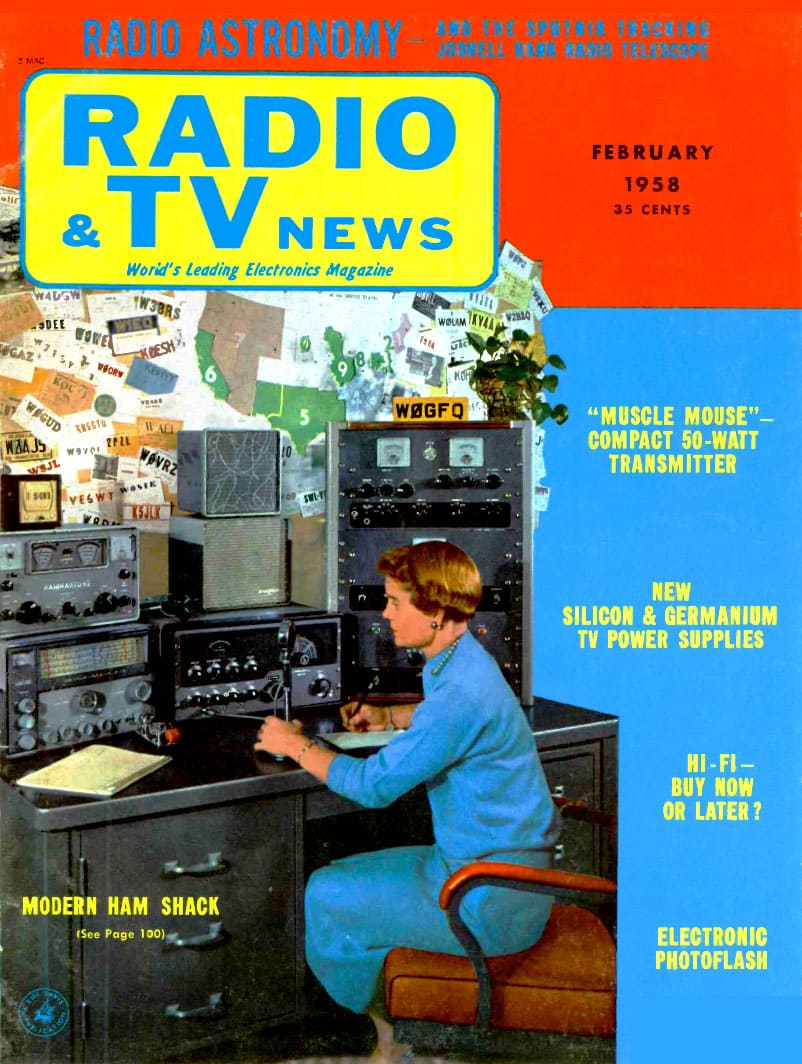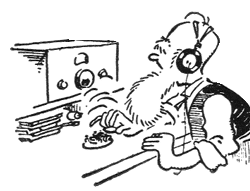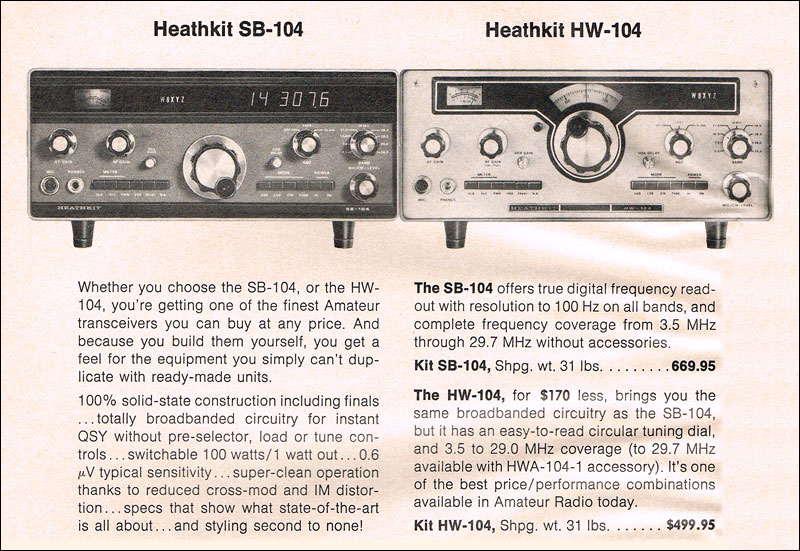This is a free fortnightly newsletter about the New Zealand Net, which meets daily at 2100 NZT on 3535 kHz.
If you would like to be notified by email when a new edition is published, please contact ZL1NZ.
Browse our Newsletter Archive and List of Net Tips.
Featured key

This old J-38 key holds an important secret! Photos: ZL1MRT
Before you scroll past this photo of an old J-38 training key, take note of the USB cable. What’s going on here?
Mark ZL1MRT created this clever little item, dubbed the “mousekey”. Not just a key, it actually contains a CW transmitter and much more, in the base.
 “Mounted on a new Kauri wood base, the mousekey is USB-powered and contains a RP2 Pico microcontroller with piezo speaker,” says Mark.
“Mounted on a new Kauri wood base, the mousekey is USB-powered and contains a RP2 Pico microcontroller with piezo speaker,” says Mark.
“The back pair of terminals supply 10mW of RF on either the 27 MHz or 7 MHz amateur bands.
“The Pico is programmable by way of the USB interface, and currently includes options selectable after power is applied. With the shorting switch engaged after one of a series of audible pips, one may select from a number of options. These currently include pre-programmed message sequences in straight CW at 20 wpm, as well as EMITSO encodings at 70 wpm using variable length T-codes or 7-bit Ascii. A short tutorial training sequence will be included shortly.
“With the shorting switch left open, the key controls a keyer operating nominally at 20 wpm.”
You read that right. Despite being merely a straight key, this old J-38 can produce self-completing dits and dahs. More to come on that subject in a future NZ Net News.
* If you have an interesting key for this feature, please send a nice clear photo and a few words describing it.
Photo flashback

Radio & TV News, February 1958
The first time I saw this magazine cover photo, I had two thoughts:
1) Why isn’t she using that nice Vibroplex?
2) Was the magazine trying to keep all its advertisers happy by featuring a shack with equipment from so many manufacturers? (Love that gorgeous Globe King transmitter!)
I can’t answer the first question, but it turns out there’s a good reason for the variety of gear on the desk, as explained inside the magazine:

New member profile: ZL1BDS, Blenheim
 By Graeme ZL1BDS
By Graeme ZL1BDS
I gained my amateur licence while at Hillmorton Hill School in Christchurch at the beginning of the ’70s. Shortly afterward, I enlisted in the RNZAF as an Air Electronics Operator to fly on P3 Orion maritime patrol aircraft. I was trained at Wigram in aeronautical and military communications, including Morse Code to 20 wpm. CW was the primary mode of military aero communications for a few years afterward, until it was eventually superseded by RTTY.
I never pursued amateur operating at this time because radio communications were part of my job. In the mid ’80s I sat the Morse tests to qualify for a Grade I licence, and I then put amateur operating aside again for another 30 years. I eventually joined the local Marlborough Branch 22 in 2016 and I have been enjoying amateur radio activities since.
I have a modest home station with a 100W transceiver and an end-fed wire antenna. I have also recently got into portable low power operation chasing POTA activations using SSB, but I’m thinking it’s time to use CW for this activity. My Morse skills are a bit rusty, but joining NZNET has provided a good stimulus to get back into it. I am enjoying the format and procedure of NZNET and hope to eventually become more involved in its operation.
Welcome aboard Graeme and here are the other members of the net.
NZ to encrypt emergency communications
The first stage of a digital radio network for some of New Zealand’s emergency responders was launched on 28 August.
The new Land Mobile Radio (LMR) Network is part of the new Public Safety Network and is being piloted in South Canterbury with eight digital radio transmission sites. Emergency services will test new radios before the LMR system is rolled out to eleven regions across the country, finishing in 2026.
The network – which is to be used by Police, Fire & Emergency, Hato Hone St John ambulance and Wellington Free Ambulance – will be fully encrypted. This is an interesting change, as currently fire and ambulance voice communications are sent in the clear on UHF FM (in Auckland, at least, not sure about the rest of the country).
“For the first time in New Zealand’s history, the four emergency services agencies will share the same radio network. This will enable greater interoperability between the organisations, bring improved efficiencies and safety for frontline staff – and ultimately, benefit the communities they serve,” says Internal Affairs Minister Brooke van Velden.
The Government’s announcement does not mention other services that might be participating in an emergency response, such as Civil Defence, Coast Guard or LandSAR, which presumably will have no access to the LMR system.
The Public Safety Network is a $1.4 billion project over 10 years to build and operate the networks and services, and roll out new devices to emergency services staff, stations and vehicles.
The LMR network will sit alongside the second component of the Public Safety Network, Cellular Services. Cellular Roaming (live since July 2023) now has 14,000 emergency services users who can roam across Spark and One NZ networks, and Cellular Priority will be live in late 2024.
The third element of the Public Safety Network involves the modernisation of ‘personal alerting’ technology. This is available to Fire and Emergency NZ and Hato Hone St John, including for use to mobilise their volunteer workforce.
Delivery of the LMR will start in Canterbury, Wellington and Auckland in 2025, followed by the project’s remaining eight regions throughout 2025 and 2026.
Morse musings: To err is human…
By Daniel Bower
 This is what I tell my CW students:
This is what I tell my CW students:
You make typos when using a computer or phone.
You mis-speak words or come out with the wrong word in oral conversation.
You make mistakes and have to scribble out words when writing. It’s why Liquid Paper was invented!
CW is the same. You’ll never be 100% perfect. Mistakes will happen – just as they do with every other form of communication you use.
Just correct it and move on. Even the very best operators make mistakes because no one communicates perfectly in any medium.
Morse demonstration at MOTAT

Photo: ZL1PX
On 18 August, visitors to the Museum of Transport and Technology (MOTAT) in Auckland got the chance to send their name in Morse Code over the air, and to hear it being sent back to them.
This was the second such event at MOTAT, and was organised by NZ Net member Peter ZL1PX with the support of the Franklin Amateur Radio Club. Despite the rainy day, more than 50 MOTAT visitors participated.
Martin ZL1MDE (pictured at left) and Steve ZL1TZP helped at the public display, while NZ Net members Paul ZL1AJY and Neil ZL1NZ responded from their home stations.
The event was conducted on 40 metres. Unfortunately, the very high electrical noise at MOTAT (they have a tram system, along with numerous gadgets and interactive displays) made it tough for the operators on-site. This noise was not just on HF, either. Even 2-metre CW was impossible.
Morse challenge
The following Morse transmission was recorded 1 Feb 2002 at 0001 UTC on 500 kHz. Your challenge is to identify the station’s callsign and then find out the year that it began operation.
Please send your answer via radiogram or email to ZL1NZ.
Answer to previous Morse Challenge
Z4AA (Frank Bell at Shag Valley, Otago) made his first contact with G2SZ (Cecil Goyder at Mill Hill School, England) on 18 October 1924. This was, of course, the first radio contact between antipodes, an unbeatable milestone that captured the world’s attention. And we are less than two months away from the 100th anniversary of this achievement.
Correct answers were received from VK2KJJ, ZL1ANY and ZL1AYN. ZL1AYN comments: “I lived at an Army Barracks in Mill Hill at age 9 to 13 from 1948 to 1952. We moved to Gosport Hampshire after my Father left the Army. I got my first callsign G3TCN in1963 living on the Welsh Border near the Brecon Beacons.”
Net tip: The prosign <AA> (line break)
When copying traffic, you may hear the special character di-dah-di-dah <AA> which is a line break.
Line breaks occur most often in the address or signature of a formal message. For example:
NR99 R ZLGD 48/24 RANGIORA 0800Z 1JAN20 = NEIL SANDERSON ZL1NZ <AA> NZ NET MANAGER <AA> 33 SEACLIFFE RD <AA> HILLSBOROUGH <AA> AUCKLAND 1042 <AA> TEL 022 106 8048 = THIS MESSAGE HAS A LONG ADDRESS AND SIGNATURE BOTH OF WHICH CONTAIN LINE BREAKS STOP LINE BREAKS ARE NOT COUNTED IN THE CHECK NUMBER = GRANT DANIEL ZL2GD <AA> NET CONTROL STATION <AA> NZ NET
The example above has as many words in the address and signature as it does in the text – but that’s not unusual in cases where messages are to be delivered to non amateurs (via post, telephone or email) or where it’s important to note a person’s position (an emergency coordinator, NZART councillor, etc.).
We don’t use standard punctuation symbols in formal traffic, so the line break helps make addresses and signatures clear.
We do NOT count special symbols such as line breaks and double dashes in the message check numbers.
First published in NZ Net News 20
Advertising archive

QST magazine, June 1976
Suggestions?
If you have suggestions on how to make the NZ Net better, or things you’d like to see covered in these updates, please contact ZL1NZ. You might even like to write something for the newsletter.
Thanks for reading, and I hope to hear you soon on the NZ Net!
—
Neil Sanderson ZL1NZ, Net Manager
New Zealand Net (NZ NET)
3535.0 kHz at 9pm NZT Daily


